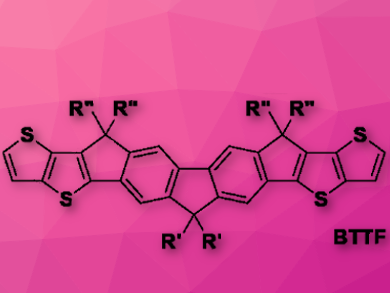Polymer solar cells (PSCs), with a photoactive blend of a p-type polymer (D) and an n-type organic semiconductor (A) in a bulk heterojunction sandwiched by a transparent electrode and a metal, have attracted much attention due to their low production costs. Fullerene derivatives are used as the mainstream n-type semiconductors as electron acceptors in PSCs.
Non-fullerene small molecular acceptors (SMAs) have easily tunable energy levels and improved absorption property compared to conventional fullerenes. The introduction of a ladder type core with fused rings offers the rigidity of the molecular geometries for reduced reorganization energy. This is beneficial for charge conduction. Extending conjugation outwards the core units improves the electron mobility and photovoltaic performance of the ladder-type SMAs by increasing local intermolecular π–π interactions.
Shengqiang Xiao, Wuhan University of Technology, China, Xinhui Lu, Chinese University of Hong Kong, Qichun Zhang, Nanyang Technological University, Singapore, and colleagues have designed and synthesized the ladder-type nonacyclic arene (bis(thieno[3,2-b]thieno)cyclopentafluorene, BTTF; pictured). They did so by fusing thienothiophenes with the fluorene core from the synthon (synthetic building block) of dimethyl 9,9-dioctyl-2,7-bis(thieno[3,2-b]thiophen-2-yl)fluorene-3,6-dicarboxylate. With BTTF as the core (central donor unit A), the team connected terminal 1,1-dicyanomethylene-3-indanones (ICs; peripheral acceptor units (D)) to form the ladder-type SMA BTTFIC.
This novel donor core unit for an A‐D‐A type non‐fullerene acceptor showed power conversion efficiencies of over 8 % when blended with both a wide‐bandgap polymer donor (PBDB‐T) and a low‐bandgap polymer donor (PTB7‐Th) in bulk heterojunction PSC devices, respectively. The optimized feeding amount of BTTFIC within the PBDB‐T:BTTFIC blend is much lower than that within the PTB7‐Th:BTTFIC blend. According to the researchers, the results show the advantage of ladder-type BTTF on the preparation of nonfullerene acceptors with extended conjugated backbones for use in PSCs.
- Ladder-Type Nonacyclic Arene Bis(thieno[3,2-b]thieno)cyclopentafluorene as a Promising Building Block for Non-Fullerene Acceptors,
Qichun Zhang, Xiaobing Fan, Jianhong Gao, Wei Wang, Shengqiang Xiao, Chun Zhan, Xinhui Lu,
Chem. Asian J. 2018.
https://doi.org/10.1002/asia.201801669



